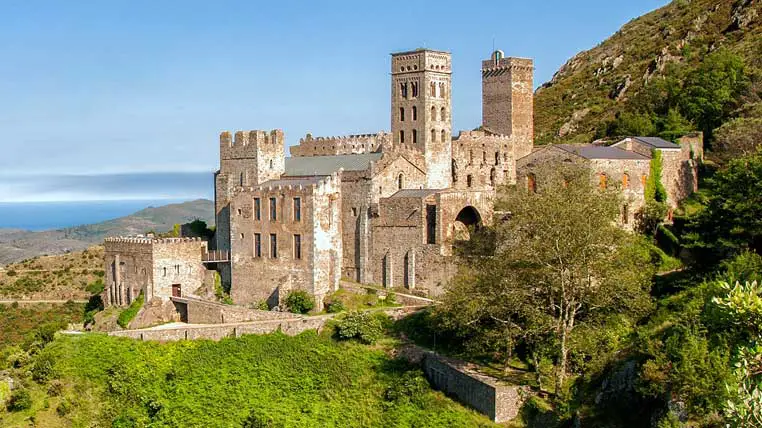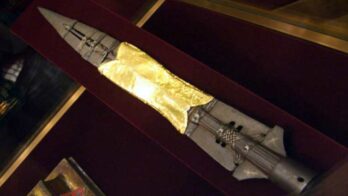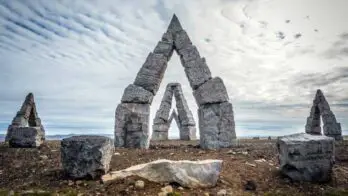The location of Saint Peter’s remains is one of Christianity’s biggest mysteries.
Saint Peter was one of the twelve apostles of Jesus Christ and is considered the first bishop of Rome. He played a significant role in the spread of Christianity and is a revered figure in the Christian faith.
In the Bible, he is often portrayed as a leader among the apostles and is known for his strong faith and devotion to Jesus.
He was later crucified upside down on the hill of the Vatican in Rome in the year 64 during the reign of Nero.
Saint Peter’s influence on the early Christian church is still felt today, making him an essential figure in Christian history and tradition.
Saint Peter's Relics: A Historical Overview
Until the 10th century, holy relics and remains were widely commercialized, with Constantinople serving as the epicenter of this intense trade.
Pilgrims, who came in large numbers to the holy places, were usually the clients, and most buyers were particularly interested in the remains of Saint Peter.
Despite centuries of search, conflicting documents and testimonies continue to cast doubt on the actual whereabouts of the remains of Saint Peter.
According to a manuscript from the 16th century, written by Jean Francois Baque in a 1991 issue of Historama magazine, the remains were removed from a crypt in the Vatican at the beginning of the 7th century and transported to the monastery of Saint Peter in Roda, located in the northeastern region of Spain, on the easternmost part of the Pyrenees Mountains.
No evidence suggests that the remains were ever returned to Rome.
So, what happened to the relics of Saint Peter? And if the remains were genuinely lost, what do Christian pilgrims worship at the Vatican?
Over time, the relics of Saint Peter were scattered in countless places, along with garments and altar coverings dispersed through various religious establishments or monasteries around the Christian world.
However, most of the remains are believed to be in the Benedictine monastery of Saint Peter in Roda (or Pedro de Roda).
This monastery, which rises majestically in the middle of a desolate landscape that enhances its grandeur, is still shrouded in mystery today.
It is covered with garriga and scattered with twisted olive trees that guard the Gulf of Leansa and Puerto de la Sierra, approximately 30 km from the French-Spanish border.
The ruins of this once-grand and glittering monastery hide the mystery that has persisted for centuries. Could this be the place where Saint Peter’s remains are buried?
The Catholic Church's Dispute and Unanswered Questions
The remains of Saint Peter, those of his disciple Saint Peter Exorcist, and those of other martyrs were taken out at the beginning of the 7th century, transported, and buried in a cave near the monastery Saint Peter in Roda.
In an audience granted by Pope Paul VI on June 28, 1978, it was stated that:
The first thing that cannot be denied by any visitor to the Vatican is the testimony of the recent scrupulous studies and conclusions of the archaeological excavations related to the Holy Sepulcher of Saint Peter. Peter is here, in the Vatican, due to the analysis of the documents, evidence, and logic.
However, the “documents,” “evidence,” and “logic” referred to by Pope Paul VI suggest a completely different truth.
Many experts agree that the place where the relics of Saint Peter are kept is an unsolved mystery in history.
In one of his works, the French historian Jérôme Carcopino (1881-1970) mentions that the relics of Saint Peter, the Holy Father of the Christian Church, were transferred in 258 to somewhere in the catacombs of San Sebastian out of fear of being desecrated by those opposed to Christianity.
They were brought back to Rome in 336 and deposited in the church of Saint Peter, thanks to Emperor Constantine the Great following the request of Pope Sylvester I (who died in 335).
But the pilgrimage of Saint Peter’s relics did not end there.
At the beginning of the 7th century, they were taken out of the Vatican to be transported to a safer place where they would be sheltered from the desecration of pagans.
A series of historians who closely knew the events, such as Boronio, Sahelico, Sacchi, Platina, Mejina, and others, mentioned in detail by Jerónimo Pujades (1568-1635) in his work Cronica Universal del Principado de Cataluña, provide us with a series of fascinating details on this matter.
Pujades claims that while visiting the monastery of San Pedro de Roda in northeastern Spain, near the Pyrenees Mountains in 1606, he discovered a manuscript in the holy place’s library with the number “223” that stated the following:
While Focas was ruling the East and the Apostolic See of Rome was occupied by Pope Boniface IV, the admiral of Babylon, at the head of a powerful Persian army, threatened Rome, coming by sea.
Reconstructing the events, it is likely that the events mentioned in this manuscript happened in 608 or 609.

The imminent threat posed by the Persian army to subjugate and devastate Rome and desecrate the earthly remains of the Apostles Peter and Paul and the other saints in the holy places of the Vatican led the Pontiff Sovereign to urgently convene a council.
Invitations were sent to high-ranking prelates, princes, and city notables.
All present agreed that part of the holy relics of the Most Blessed Saint Peter (his head and right arm), the body of his disciple Saint Peter Exorcist, as well as the remains of the Christian martyrs Concordis, Lucidino, and Moderando, should be removed from Rome and transported through trustworthy people to France, to rest in a safe place until the end of the persecution threatening them.
Pope Boniface IV added to these relics a flask that is said to have contained the blood of Jesus Christ.
Together with the clergy who had taken part in the council, a procession accompanied the holy relics to the ship anchored in the port.
Laid aboard with solemnity, they were accompanied by some trustworthy ecclesiastics, including the brothers Feliu, Poncio, and Epicino.
The Cave of Saint Paul
The ship followed the downward course of the Tiber and entered the Mediterranean Sea.
Driven by a strong wind, after a few days of navigation, it reached the port of Armen de Roda, nowadays called Puerto de la Sierra, situated perpendicularly to the chain of the Pyrenees, separating France from Spain.
Glad to have escaped unscathed and arrived safely ashore, the crew remained on the ship for three days, offering thanks to God in prayer.
Due to low water supplies, some went ashore searching for fresh water.
The events that followed are recounted in the Universal Chronicle of the Principality of Catalonia by Jeronimo Pujades:
The men climbed the daring mountain called Verdera and from the summit beheld a vast plain called Ampuradan, the sea, numerous lagoons, and ponds in the abyss caused by the collapse of the Pyrenees towards the coast. Lower down the peak, they found a crystal-clear spring of cold water and, close to it, a cave dominated by a small altar that Saint Paul had erected during the two or three years he had spent here when he was Bishop of Narbonne.
The monks considered it a suitable place to bury the earthly remains of the saint, so they took the relics from the ship in secrecy and laid them at the bottom of the cave, which they made sure to fill up before leaving.
When they returned a few months later, after the danger had passed, they found it impossible to find the burial site owing to the abundance of thorny vegetation that had overgrown the surroundings in their absence.
Understanding that they could not recover the precious sacred treasure, they settled there until death, except for two of them who returned to Rome to give an account of the journey’s outcome.
Pope Boniface IV, taking note of what had happened, considered it inappropriate for the place to remain empty and, to mark it, ordered the construction of an imposing monastery.
Even More Controversies
The Monastery of St. Peter of Roda was visited and praised by Charlemagne in 778.
Although the Arab invasion of 711 did not cause any damage to the building, the Moorish offensive of 798 partially affected the monastery, causing significant destruction.
The Moors, coming from North Africa, intended to regain the lands they had lost during the time of Louis the Pious (778-840), the son of Charlemagne, who was born in Chasseneuil and was king of the Franks between 814 and 840.
A difficult period for the monastery followed when it was forgotten and left abandoned due to the vicissitudes of the times.
The construction deteriorated, especially as a result of numerous Moorish expeditions.
It all lasted until 944 when the architect Tassis began the restoration work of the building, an operation that continued even after his death, ending only in 1022.
Concerning the building, there has been a long-standing mystery surrounding the presence of Corinthian capitals in a basilica inspired by Visigoth and Roman architecture.
It is worth noting that the Visigoths emerged in the fourth century in the Danube region and converted to Arianism.
They conquered Rome in 410 and were installed as federates in the southeast of Gaul in 418.
Later, they conquered a significant part of Spain in 476. However, they were defeated by the Arabs in 711.
The explanation for the Corinthian capitals was discovered much later, taking into account a statement in Ptolemy’s book, which mentioned that the temple of the goddess Venus from the Pyrenees was located on the Verdera mountain.
Like most of the builders of that time, the Benedictine monastery builders used the building materials found in the vicinity of the new building.
In this case, they recovered some Greek treasures belonging to the former temple of the goddess Venus.
According to historians, the remains of St. Peter and other martyrs were transferred to the Monastery of St. Peter of Roda.
Historical sources do not mention the return of the remains of St. Peter to the Vatican.
Catalan historian Alexandre Deulofeu stated, “If there is a certainty that the remains of Peter were taken out of Rome, there is no evidence of their return to this city.”
Several historians and scientists, including clerics, have observed that the fact of the return of the remains could not have gone unnoticed and would have been mentioned in chronicles or historical reports or at least transmitted through oral tradition.
Therefore, it is likely that the relics remained on Catalan soil.

Is the Vatican Lying About the Location of Saint Peter's Remains?
An indication that supports this theory is that Pope Urban II granted the same indulgences in 1090 to the faithful who went on a pilgrimage to the Cathedral of Saint Peter at the Vatican and those who went to the Monastery of Saint Peter in Roda.
Moreover, what motive could Pope Boniface IV have had to order the construction of a grandiose monastery in a forgotten area on the eastern border of Spain?
The testimony of history, combined with logical arguments, leads us to the conclusion that the remains of Saint Peter – entirely or partially – rest in Catalan soil.
However, research conducted by the Vatican in 1915 revealed a series of catacombs frequented by Christians under the Basilica of Saint Sebastian on the Via Appia, which proved the earthly remains of Saints Peter and Paul were located there.
This fact was confirmed by the statements of Pope Damasus I and the confirmation of the transfer of the relics in 258.
In 1914, a trophy identical to the one offered by the pretor Gaius to Saint Peter at the end of the second century was discovered during excavations carried out under the basilica of Saint Peter at the Vatican.
However, according to historian Charles Meunier in The History of Saints and Sanctity (Editions Hachette, Paris), the space presumed to house the remains of Saint Peter is way too small.
In 1951, Pope Pius XII assigned eminent professors from the Pontifical Institute of Christian Archaeology, led by Cardinal Engelbert Kirschbaum and archaeologist Enrico Tosi, to carry out new excavations.
Unfortunately, the results were disappointing.
Today, visitors to the Vatican enter a museum that houses a series of valuable objects, especially archaeological ones.
A narrow corridor descends into the vaults of the Vatican, where high pontifical hierarchs are buried. At the last level, the remains of a small church where Saint Peter officiated can be found.
However, the reliability of the identification of Saint Peter’s tomb is in doubt.
In the Osservatore Romano of June 29-30, 1976, and June 29, 1978, it was mentioned that the homily of June 29, 1976, pronounced by Pope Paul IV of the Saints Peter and Paul, expressed certainty that the tomb of Saint Peter is in the place where the basilica dedicated to him was built.
Despite this statement, the Catholic Church disputes all this historical evidence, and Saint Peter’s relics dossier is not closed.
It is evident that the relics of Saint Peter have yet to be returned to Rome, and they are not deposited at the Vatican.
This raises questions about to whom the faithful pilgrims to the Vatican are praying and where the relics of Saint Peter, the father of the Christian church, are located.
Perhaps only a new series of archaeological excavations could contribute to the elucidation of the mystery still prevailing.
We may not find the answers to these questions until new excavations occur at the Monastery of Saint Peter in Roda.
At Ancient Theory we only use trusted sources to document our articles. Such relevant sources include authentic documents, newspaper and magazine articles, established authors, or reputable websites.
- Saint Peter's tomb. wikipedia.org. [Source]
- Roger T. O'Callaghan - Vatican Excavations and the Tomb of Peter. The Biblical Archaeologist.
- N. S. Gill - Saints of the Early Christian Church.
- Fr. Raymond de Souza - The inexplicable transfer of St Peter’s relics to Constantinople.
- Colin Schultz - Are These the Bones of Saint Peter?
- Vatican Puts St. Peter's Bones On Display For The First Time. npr.org.






